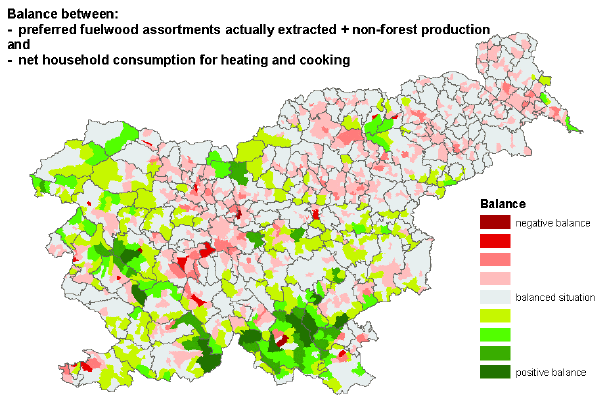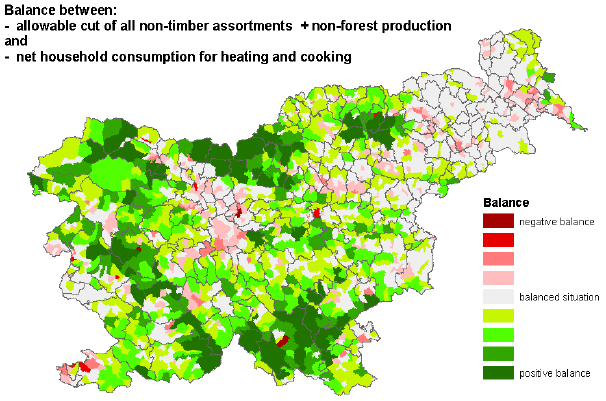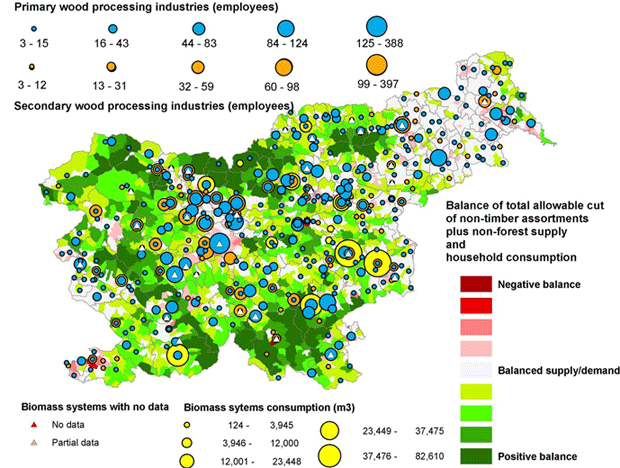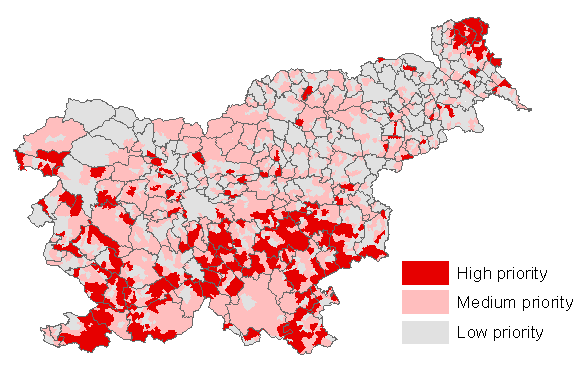


Before the project, several studies were conducted on various aspects of wood energy in Slovenia [5] [6] [10] but the information remained largely fragmented and incomplete. A comprehensive vision of the wood energy sector was missing and, most relevant, there was no clear perception of the importance of woodfuels among forest products and of the share of wood fuels in the national energy mix.
Particularly weak was the information on the level of fuelwood consumption in the household sector, which is by far the main user of wood energy, on the role played by non-forest land uses as sources of fuelwood in rural areas and on the production/consumption of industrial wood residues. The investigation carried out in the framework of the project, and particularly through the development of WISDOM, allowed for the filling major information gaps-- for years of reference data (2000 – 2002) and to build a first complete vision of this sector and its potential.
The main results and findings of the Information Component of the project are presented following the two main steps that led to the construction of a comprehensive national information resource:
• The development of the Slovenia WISDOM geodatabase
• The Slovenia Wood Energy Information System (SWEIS)
In this section only the results and findings that were considered most relevant for a comprehensive view of the wood energy sector are presented. They are the final outcome and synthesis of the combination of several thematic layers each of which represent an important result of the study. The intermediate results include, for instance, estimation and mapping of fuelwood consumption; mapping of current and potential forest biomass production, woody biomass resources and productivity of farmlands, pastures and other non-forest lands; and others. These thematic layers and relevant results are presented in the following sections that describe the development of WISDOM and SWEIS.
The Slovenia WISDOM allowed a first holistic and coherent vision of the main aspects of fuelwood demand and supply and their spatial relation. It provided, for each of the 2696 Cadastral Communities (KO) that compose the Country, all variables relevant to the wood energy sector that could be assembled from a variety of sources and/or estimated through analytical processes and surveys.
The spatial and statistical data was structured in form of geodatabase, named KOWISDOM, which combined the spatial and statistical elements and allowed a convenient handling and presentation in both Microsoft Access (database features) and ESRI ArcMap environments.
Annex 4 describes the attributes of the geodatabase which include over 110 parameters associated to the 2697 KOs and some 20 parameters associated to the 5997 point data. Annex 4 also provides the summary value at national level of all parameters associated to the map. Many of these national level results were used as input to the SWEIS.
Main findings
The following maps (Figures 1 to 3) present few selected thematic aspects resulting from the WISDOM analysis. These are only few themes out of the vast “wood energy atlas” that can be mapped on the basis of the geodatabase. The selected themes refer to basic questions such as the balance and pattern of current fuelwood consumption and production, the production potential of woody biomass with reference to current forest management plans, the spatial distribution of existing wood industries and biomass systems, and an example of priority zoning combining several parameters of the geodatabase.
Figure 1 shows current fuelwood consumption/production situation. The map reports the balance between actual extracted wood from preferred fuelwood species (all non-timber assortments from hard broadleaved and Larch) plus the wood produced outside forests and the household consumption of fuelwood. The estimated national summary values are shown in Table 2 further below.
Figure 1: Spatial pattern of current fuelwood production/consumption situation.

Figure 2: Spatial pattern of potential fuelwood production/consumption balance between current non-timber allowable cut plus the estimated non-forest productivity and household consumption. Overall balance is estimated to be over + 1.1 million m3. The darker green areas indicate the locations with highest woody biomass surplus, where, for instance, new wood energy systems could be located.

Figure 3: Distribution of wood processing industries and biomass systems on the background of the potential sustainable supply of woody biomass shown in Figure 2.

Figure 4: Example of priority zoning derived from the combination of three thematic elements: high property fragmentation; high wood surplus considering current local consumption and potential sustainable productivity; high fraction of forests at thinning stage.

Figure 2 shows the potential sustainable surplus of woody biomass on which the expansion of wood energy could be based. The map reports the balance between the total allowable cut of all non-timber assortments from all species plus the wood produced outside forests and the estimated household fuelwood consumption. The national summary value is shown in No. 2 in Table 2 (darker grey). This estimation is very conservative since it is based on a total allowable cut (timber and non-timber assortments) of less than 4 million m3, while it is known that Slovenia forests have an annual increment above 7 million m3. Therefore, the real amount of wood available for energy use (here estimated at 1,144 million m3) could be more than doubled without interfering with the timber and fiber industries and remaining within the limits of sustainable forest productivity.
Figure 3 shows the distribution of biomass systems, including district heating systems, combined heat and power plants and other non-specified wood-based systems, as well as primary and secondary wood processing industries. Most biomass systems are fed by residues from wood processing industries and many of them are located within the industries themselves to supply part of the energy needed for their production processes. In order to visualize the areas suitable for the installation of new plants, the existing industrial plants are shown on the background of the potential sustainable supply of woody biomass (shown in Figure 2).
Figure 4 shows, as an example of priority zoning, the areas of the country most suitable for the implementation of field programs oriented toward: (i) the promotion of forest owners associations, (ii) the increase of woodfuel production and (iii) the carrying out of thinnings in overstocked forests and, consequently, the amelioration of future timber quality. These priority areas were determined through the combination of three aspects such as high property fragmentation, high wood surplus considering current local consumption and potential sustainable productivity, and high fraction of forests at thinning stage (early and late pole stages).
This dataset is meant to be used and reviewed by forestry and energy experts in order to validate the underlying assumptions and to keep them up-to-date. This in itself must be considered an important result of the WISDOM approach since demand and supply estimates are consistently combined for the first time and offer an unprecedented basis for inter-sectoral discussion.
Based on the current data stage of analysis, the following key findings may be highlighted:
• Approximately 1.9 million m3 (mm3) of wood were used as an energy source in Slovenia in 2002, of which 1.3 mm3 is used by the household sector 0.6 mm3 by the industrial sector--including biomass energy systems. It appears that there are two fairly independent woodfuel circuits: one household circuit that uses mainly fuelwood from forests and farmlands (and marginally charcoal) and one industrial circuit that uses mainly residues from wood industries and paper mills.
• According to Statistical Office of Slovenia the national fuelwood production for year 2002 was 280 000 m3, which is only 22% of the consumption estimated by the project. Similarly, the assortment specifically classified as “fuelwood” in forestry databases represents only 17% (assortment’s allowable cut) of the volume actually used as fuel, although all foresters recognize that other non-timber assortments are also primarily used as fuel. These gross inadequacies in quantifying fuelwood production show in some way that the energy use is not adequately recognized in the national context. Most relevant, this situation misleads the analysis of forest role in the energy sector as well as that of national energy statistics.
• The forest product commonly used as fuelwood was grouped in the assortment category called “Non-timber assortments commonly used as fuel” (Table 1) which includes the non-timber quality assortments of several species. On average, some 840 000 m3 of this assortments group were annually extracted in the period 1991-2001. At present, considering the higher extraction rate, the extracted amount is likely to be around 1 million m3.
• Particularly relevant appears the ratio between the volumes actually extracted and the allowable cut, which seems to depend primarily on property fragmentation. This ratio was 0.6 over the period 1991-2001 (on average 0.54 in private forests and 0.76 in state forests) but in recent years it seems to have increased approximately 0.7.
• The standing volume in non-forest areas (including meadows, abandoned agriculture, agro-forestry, urban areas, orchards, etc.) amounts to some 11.5 million m3, with an estimated annual increment of some 400 000 m3. From this resource, approximately 300 000 m3 are believed to be used as fuel every year7.
• The second assortment class “Non-timber assortments of all species” (Table 2) represents the potential wood energy supply for household and industrial use in the near future--if the actual extraction will be increased to match the sustainable production capacity or at least the conservative levels defined by forest managements’ allowable cut.
In maintaining and strengthening the WISDOM geodatabase some thematic aspects that are now preliminarily covered should be further developed or completed (as described in the Recommendations section) and included in the next versions of the geodatabase.
WISDOM is conceived as a strategic planning tool to be maintained, deepened and, most important, used by wood energy planners. In this respect, the analytical conclusions and priority zoning so far defined should be considered as the first steps in the analysis of this sector and not the conclusion of a process. The priority zoning carried out, for instance; was an example of analysis rather than the definition of true priorities. Many other aspects can, and hopefully will, be mapped by wood energy planners using the WISDOM geodatabase.
In order to produce a first coherent overview of current levels of woodfuels production, import, export and consumption in Slovenia, WISDOM data was integrated with additional data from a wide variety of sources [2] [11] [12] [14]. This comprehensive dataset constitutes the Slovenia Wood Energy Information System (SWEIS), which is summarized in Table 1.
SWEIS data is complete for year 2002, for which all components could be assessed. Still missing are time series data for household and industrial consumption, which prevented the computation of total production and consumption estimates for the other years and the estimation of trends.
Estimates for 2002 were computed as follows:
• insertion of the available information on import and export;
• estimation of household consumption (see WISDOM analysis);
• estimation of industrial consumption;
• estimation of industrial production;
• insertion of charcoal production data;
• estimation of fuelwood production in non-forest lands (see WISDOM analysis);
• calculation of fuelwood production from forest resources.
Some values had to be estimated because specific fuelwood production statistics did not exist and took into consideration the fact that that fuelwood production is demand-driven and not independent. In fact, in a general national context woodfuel production is equal to woodfuel consumption (minus export plus import), since large accumulations and storage beyond the annual consumption are uncommon.
While Table 1 accounts for the wood used for energy in terms of cubic meters, highlighting the importance of this product for the forestry sector, it is also important to consider it in terms of energy and to evaluate the contribution of this sector to meet the national energy demand and to assess its future potential. In order to provide the first elements of analysis, Annex 7 gives the values of Table 1 converted into energy units.
A direct comparison between SWEIS energy estimates and the Slovenia Yearbook energy statistics cannot be done, since the energy balance does not report woodfuels individually but groups all renewables and municipal/industrial waste together. Again, like for forestry statistics, wood energy is seen as a minor item and receives little attention. It is essential and highly recommended that in future statistical surveys of both forestry and energy sectors specific attention be given to the production and consumption of individual woodfuels.
Table 1: SWEIS - Slovenia Wood Energy Information System. National level statistics. Values in ‘000 m3.
|
1995 |
1996 |
1997 |
1998 |
1999 |
2000 |
2001 |
2002 |
Production |
|
|
|
|
|
|
|
(1,952) |
Fuelwood |
||||||||
Forests |
|
|
|
|
|
|
|
1,0123 |
Other land uses |
|
|
|
|
|
|
|
276 |
Industries (residues) |
722 |
695 |
669 |
644 |
620 |
597 |
575 |
553 |
Charcoal1 |
1.2 |
1.2 |
1.3 |
1.4 |
1.4 |
1.6 |
1.5 |
1.9 |
Black Liquor |
109 |
109 |
109 |
109 |
109 |
109 |
109 |
109 |
Import |
|
|
|
|
|
|
|
(3) |
Fuelwood |
12 |
|
|
10 |
17 |
2 |
1 |
1 |
Charcoal1 |
2.2 |
2.1 |
2.0 |
1.9 |
1.9 |
1.7 |
1.7 |
1.8 |
Black Liquor |
|
|
|
|
|
|
|
|
Export |
|
|
|
|
|
|
|
(60) |
Fuelwood |
75 |
|
|
89 |
75 |
62 |
55 |
60 |
Charcoal |
|
|
|
|
|
|
|
|
Black Liquor |
|
|
|
|
|
|
|
|
Consumption |
|
|
|
|
|
|
|
(1,895) |
Household Sector |
|
|
|
|
|
|
|
|
Fuelwood |
|
|
|
|
|
|
|
1282 |
Charcoal1 |
3.4 |
3.3 |
3.3 |
3.3 |
3.3 |
3.3 |
3.2 |
3.7 |
Black Liquor |
||||||||
Other Sectors (industrial, public, etc.) |
|
|
|
|
|
|
|
|
Fuelwood |
|
|
432 |
|
|
|
|
5002 |
Charcoal |
|
|
|
|
|
|
|
|
Black Liquor |
109 |
109 |
109 |
109 |
109 |
109 |
109 |
109 |
Notes:
Figures in bold represent reference values. Other figures are extrapolated values.
1 Estimated wood used for charcoal production. Conversion factor:
1 t of charcoal = 6 m3 of wood.
2 Available 2002 data on 31 biomass systems total 391 102 m3.
Value tentatively expanded to 500 000 m3 to include the 34 biomass
systems for which consumption data was missing.
3 The Fuelwood from forests was estimated as total production (total
consumption + export – import) minus all other production values (Fuelwood
from other land uses and industries, Charcoal and black Liquor).
Woody biomass potential
In addition to estimating consumption levels, which are essential to the development of the SWEIS, a comprehensive study was done, as part of the WISDOM analysis, to assess the current and potential sustainable woodfuel production and its spatial distribution. Specifically, the following aspects were analyzed in great detail:
• the actual and potential sustainable production, from Slovenia managed forests, of wood assortments of non-timber quality suitable for wood energy uses;
• the stocking and productivity of woody biomass on non-forest land uses, including abandoned farmlands, mixed agro-forestry systems, meadows, orchards, urban areas, croplands, etc.).
Table 2 presents the main results of the supply study and an estimation of various consumption/production balances in respect of different production scenarios.
In Slovenia there are two fairly independent woodfuel circuits [12]:
• a “household” circuit that uses mainly fuelwood (and marginally charcoal) from forests and farmlands, and
• an “industrial” circuit that uses mainly residues from wood industries and paper mills.
Table 2 refers to the first circuit, analyzing the relation between the forest/non-forest productivity of fuelwood assortments and household consumption.
Concerning the wood products actually extracted from the forests (points 3 and 4 in Table 2) there is an approximate zero balance between the household consumption and the production from forests (limited to the traditionally preferred wood assortments) and from other land uses. The negative value (- 164 000 m3) is due to the low cutting rate of the 1990’s. Since the consumption estimate refers to year 2002, an attempt was made to update the “extraction factor” according to recent years’ data (where it seems to be significantly higher). Accordingly, recent extraction rates were estimated around 1 million m3, thus balancing (together with the estimated non-forest fuelwood) the household demand.
The analysis shows that at current extraction rates some half million m3 of wood could be used for additional energy applications. These applications would be primarily industrial because this surplus wood is mainly coniferous and hence not suited for household consumption [11].
Table 2: Fuelwood consumption/production balances between annual estimated household consumptions and annual fuelwood production from forests and other land uses (currently or potentially used as fuelwood). Values in ‘000 m3.
Fuelwood Production |
Household Fuelwood Consumption |
||||
| Forests |
Non-forest land uses |
1,280 |
|||
Allowable cut of all assortments (timber and non-timber) |
3,927 |
394 1 |
Balance |
||
Allowable cut from management plans |
|||||
1 - Non-timber assortments commonly used as fuel (group BCD)4 |
1,407 |
276 2 |
404 |
||
2 - Non-timber assortments of all species (all conifers included) |
2,148 |
|
|||
Volumes actually extracted 3 |
Avg |
Recent cut rate |
Avg |
Recent cut rate |
|
3 - Non-timber assortments commonly used as fuel (group BCD)4 |
840 |
~ 1,000 |
|
~ 0 |
|
4 - Non-timber assortments of all species (all conifers included) |
1,283 |
~ 1,500 |
280 |
~ 500 |
|
Actual cut of all assortments (timber and non-timber). Ten-years average 1991-2001 |
2,366 |
2,800 |
|||
1 Estimated Mean Annual Increment of woody vegetation
in non-forest land uses.
2 Exploitable volume estimated as 70% of Mean Annual Increment
3 During the period 1991-2001 the actual cut was 54% of allowable
cut in private forests and 76% in state forests). In recent years the cut
amount reached approximately 2.8 million m3 [11].
4 See Annex 5 for explanation.
Shaded balances are shown in Figures 1 and 2 below.
Regarding the entire allowable cut (points 1 and 2) there is a potential surplus that ranges between 0.4 and over 1.1 million m3. These surpluses must be considered as very conservative because they refer to an allowable cut of 4 million m3 while it is known that the annual increment of Slovenia forests is above 7 million m3 [11]. This means that the true sustainable potential could easily be well above 2 million m3 per year without affecting forest sustainability or wood industries; on the contrary, a more intense exploitation for energy purposes, which would include the execution of thinning operations, would be highly beneficial for the health of the forests and for the quality of timber products.
Draft wood energy strategy
The results of the Information Component, along with the results from other project components on Economics and Institutional Aspects, were used at the end of the Project to formulate a proposal for a national “wood energy strategy” for the Slovenian Forestry Service, to be combined with other forestry and energy plans as well as international conventions and agreements approved by the Government.
The strategy formulated recommended increasing the national annual woodfuel production/consumption up to (at least) 3 million m3 before the year 2020. In this way, wood energy could reach an annual contribution of 30 PJ to the national energy balance representing around 10% (at present around 7%) of the total primary national energy consumption.
It is important to highlight, however, that the major constraint to the full development of the wood energy potential of the country is not from the exploitable amounts of woody biomass, which appear definitely abundant. The main constraints are with the institutional settings, including the lack of a dedicated branch within the Forest Service, the lack of specific legal and regulatory measures, and with the low poor incentives for forest owners to implement management prescriptions. In this respect it is necessary to promote forest owners associations to combat property fragmentation and to raise forest owners’ economic interest by internalizing the multiple social, economic and environmental benefits deriving from an increased production of woodfuels.
7 These values represent the first estimation ever done of non-forest woody biomass. However, since the variance of tree cover outside the forest is extremely high, the margin of error is very wide and they should be considered indicative only